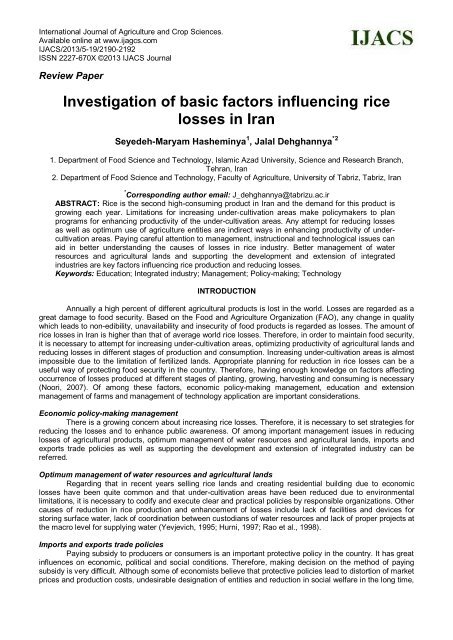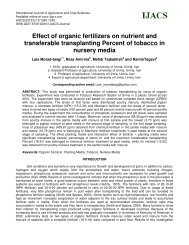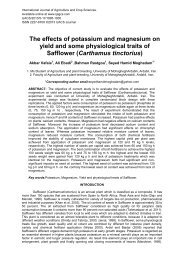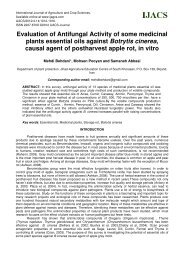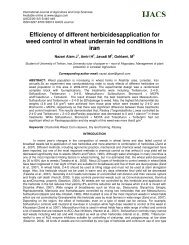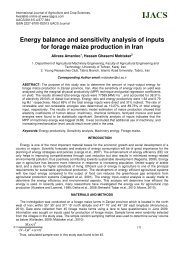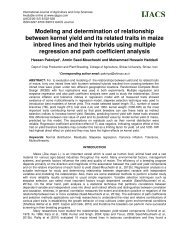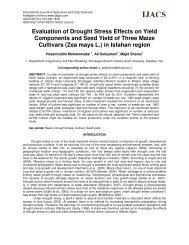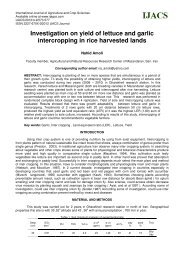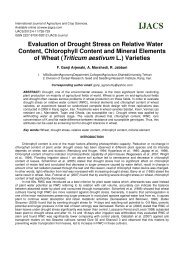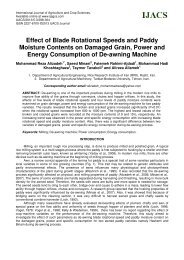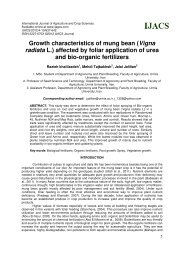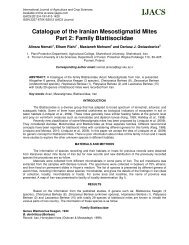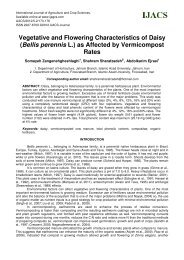2190-2192 - International Journal of Agriculture and Crop Sciences ...
2190-2192 - International Journal of Agriculture and Crop Sciences ...
2190-2192 - International Journal of Agriculture and Crop Sciences ...
Create successful ePaper yourself
Turn your PDF publications into a flip-book with our unique Google optimized e-Paper software.
<strong>International</strong> <strong>Journal</strong> <strong>of</strong> <strong>Agriculture</strong> <strong>and</strong> <strong>Crop</strong> <strong>Sciences</strong>.<br />
Available online at www.ijagcs.com<br />
IJACS/2013/5-19/<strong>2190</strong>-<strong>2192</strong><br />
ISSN 2227-670X ©2013 IJACS <strong>Journal</strong><br />
Review Paper<br />
Investigation <strong>of</strong> basic factors influencing rice<br />
losses in Iran<br />
Seyedeh-Maryam Hasheminya 1 , Jalal Dehghannya *2<br />
1. Department <strong>of</strong> Food Science <strong>and</strong> Technology, Islamic Azad University, Science <strong>and</strong> Research Branch,<br />
Tehran, Iran<br />
2. Department <strong>of</strong> Food Science <strong>and</strong> Technology, Faculty <strong>of</strong> <strong>Agriculture</strong>, University <strong>of</strong> Tabriz, Tabriz, Iran<br />
* Corresponding author email: J_dehghannya@tabrizu.ac.ir<br />
ABSTRACT: Rice is the second high-consuming product in Iran <strong>and</strong> the dem<strong>and</strong> for this product is<br />
growing each year. Limitations for increasing under-cultivation areas make policymakers to plan<br />
programs for enhancing productivity <strong>of</strong> the under-cultivation areas. Any attempt for reducing losses<br />
as well as optimum use <strong>of</strong> agriculture entities are indirect ways in enhancing productivity <strong>of</strong> undercultivation<br />
areas. Paying careful attention to management, instructional <strong>and</strong> technological issues can<br />
aid in better underst<strong>and</strong>ing the causes <strong>of</strong> losses in rice industry. Better management <strong>of</strong> water<br />
resources <strong>and</strong> agricultural l<strong>and</strong>s <strong>and</strong> supporting the development <strong>and</strong> extension <strong>of</strong> integrated<br />
industries are key factors influencing rice production <strong>and</strong> reducing losses.<br />
Keywords: Education; Integrated industry; Management; Policy-making; Technology<br />
INTRODUCTION<br />
Annually a high percent <strong>of</strong> different agricultural products is lost in the world. Losses are regarded as a<br />
great damage to food security. Based on the Food <strong>and</strong> <strong>Agriculture</strong> Organization (FAO), any change in quality<br />
which leads to non-edibility, unavailability <strong>and</strong> insecurity <strong>of</strong> food products is regarded as losses. The amount <strong>of</strong><br />
rice losses in Iran is higher than that <strong>of</strong> average world rice losses. Therefore, in order to maintain food security,<br />
it is necessary to attempt for increasing under-cultivation areas, optimizing productivity <strong>of</strong> agricultural l<strong>and</strong>s <strong>and</strong><br />
reducing losses in different stages <strong>of</strong> production <strong>and</strong> consumption. Increasing under-cultivation areas is almost<br />
impossible due to the limitation <strong>of</strong> fertilized l<strong>and</strong>s. Appropriate planning for reduction in rice losses can be a<br />
useful way <strong>of</strong> protecting food security in the country. Therefore, having enough knowledge on factors affecting<br />
occurrence <strong>of</strong> losses produced at different stages <strong>of</strong> planting, growing, harvesting <strong>and</strong> consuming is necessary<br />
(Noori, 2007). Of among these factors, economic policy-making management, education <strong>and</strong> extension<br />
management <strong>of</strong> farms <strong>and</strong> management <strong>of</strong> technology application are important considerations.<br />
Economic policy-making management<br />
There is a growing concern about increasing rice losses. Therefore, it is necessary to set strategies for<br />
reducing the losses <strong>and</strong> to enhance public awareness. Of among important management issues in reducing<br />
losses <strong>of</strong> agricultural products, optimum management <strong>of</strong> water resources <strong>and</strong> agricultural l<strong>and</strong>s, imports <strong>and</strong><br />
exports trade policies as well as supporting the development <strong>and</strong> extension <strong>of</strong> integrated industry can be<br />
referred.<br />
Optimum management <strong>of</strong> water resources <strong>and</strong> agricultural l<strong>and</strong>s<br />
Regarding that in recent years selling rice l<strong>and</strong>s <strong>and</strong> creating residential building due to economic<br />
losses have been quite common <strong>and</strong> that under-cultivation areas have been reduced due to environmental<br />
limitations, it is necessary to codify <strong>and</strong> execute clear <strong>and</strong> practical policies by responsible organizations. Other<br />
causes <strong>of</strong> reduction in rice production <strong>and</strong> enhancement <strong>of</strong> losses include lack <strong>of</strong> facilities <strong>and</strong> devices for<br />
storing surface water, lack <strong>of</strong> coordination between custodians <strong>of</strong> water resources <strong>and</strong> lack <strong>of</strong> proper projects at<br />
the macro level for supplying water (Yevjevich, 1995; Hurni, 1997; Rao et al., 1998).<br />
Imports <strong>and</strong> exports trade policies<br />
Paying subsidy to producers or consumers is an important protective policy in the country. It has great<br />
influences on economic, political <strong>and</strong> social conditions. Therefore, making decision on the method <strong>of</strong> paying<br />
subsidy is very difficult. Although some <strong>of</strong> economists believe that protective policies lead to distortion <strong>of</strong> market<br />
prices <strong>and</strong> production costs, undesirable designation <strong>of</strong> entities <strong>and</strong> reduction in social welfare in the long time,
Intl J Agri <strong>Crop</strong> Sci. Vol., 5 (19), <strong>2190</strong>-<strong>2192</strong>, 2013<br />
some other think that they result in retaining occupation, increasing farmers income, decreasing poverty,<br />
supporting domestic producers, encouraging exports <strong>and</strong> alleviating dependency. In order to improve economic<br />
situation <strong>of</strong> Iranian farmers, some protective policies are used including providing entities needed for farmers<br />
such as fertilizers <strong>and</strong> pesticides, extending insurance coverage for agricultural products, pricing <strong>and</strong><br />
guaranteed purchasing <strong>of</strong> agricultural products from farmers directly, protecting agricultural products from<br />
unexpected events <strong>and</strong> paying loans with low interest for purchasing agricultural machineries. It seems that<br />
paying subsidy in Iran can cause problems such as development <strong>of</strong> losses due to inefficiency <strong>of</strong> distribution<br />
system <strong>and</strong> lack <strong>of</strong> coordination between responsible authorities (Razini Rahmani, 2002; Noori, 2005).<br />
Use <strong>of</strong> an appropriate tariff system is another protective policy device against irregular imports. In other<br />
words, in order to prevent from importing foreign goods with a lower price compared to a desirable protective<br />
price, tariff system should be exercised in such a way that import <strong>of</strong> the foreign goods with a lower price will not<br />
be possible. Some problems in current trend <strong>of</strong> rice tariff rate policies lead to inefficiency <strong>of</strong> the aforesaid<br />
protective policy. Therefore, it is necessary to modify the determination method <strong>of</strong> imported rice tariff (Noori,<br />
2004).<br />
Pricing <strong>and</strong> guaranteed purchase <strong>of</strong> rice are other protective policies. In order to retain price <strong>of</strong> an<br />
agricultural product in the market, the government attempts to determine guaranteed price <strong>and</strong> to purchase the<br />
product. The aim <strong>of</strong> this policy is to protect producers (Noori, 2007). However, in some instances, due to lack <strong>of</strong><br />
precise planning <strong>and</strong> expertise, guaranteed purchase rate <strong>of</strong> rice is much lower than its finished cost. In other<br />
words, farmers are not satisfied with selling their products <strong>and</strong> are reluctant to plant rice in the future.<br />
Supporting the development <strong>and</strong> extension <strong>of</strong> integrated industries<br />
Supporting capitalists in order to establish processing factories <strong>and</strong> to reduce rice losses is an effective<br />
protective strategy (Pilat, 1995). Appropriate planning, protecting capitalists in private section <strong>and</strong> allocating<br />
credits especially to related projects can encourage establishing rice factories. It should be mentioned that<br />
issuance <strong>of</strong> license for the establishment <strong>of</strong> integrated industries should be proportionate to raw material<br />
potential as well as to marketing conditions <strong>of</strong> these products.<br />
Education <strong>and</strong> extension management <strong>of</strong> farms<br />
Educating rice farmers by experienced promotion agents can be a great step for optimum use <strong>of</strong><br />
agricultural entities; i.e. farmers can better manage their farm with the aid <strong>of</strong> scientific information received from<br />
experts. Knowing factors affecting farm productivity is an educational aim <strong>of</strong> rice farmers. These factors include<br />
applying appropriate amount <strong>of</strong> fertilizers, pesticides <strong>and</strong> herbicides, educating about temperature <strong>and</strong> moisture<br />
variations, seed nature <strong>and</strong> quality <strong>of</strong> soil <strong>and</strong> water as well as engineering under-cultivation areas with the use<br />
<strong>of</strong> modern technologies. Some farmers using inappropriate amounts <strong>of</strong> fertilizers, pesticides <strong>and</strong> herbicides, in<br />
addition to the loss <strong>of</strong> the national wealth, their savings, agriculture <strong>and</strong> environmental pollution, can cause<br />
increased pests <strong>and</strong> diseases, plant lodging, plant available water reduction, non-inoculation <strong>and</strong> osteoporosis<br />
occurrence. Appropriate promotional education can aid farmers in improving the amount <strong>of</strong> fertilizers <strong>and</strong><br />
pesticides used. Of other promotional points we can refer to description <strong>of</strong> temperature variations effect <strong>and</strong> its<br />
consequent losses. For example, if nylon covers are not used at building rice exchequers, chilblain <strong>of</strong> seedling,<br />
retardation <strong>of</strong> seedling growth <strong>and</strong> in some instances destruction <strong>of</strong> whole exchequer will be probable. Also,<br />
high temperature in exchequer leads to irregular maturation <strong>of</strong> rice grains in addition to product loss due to high<br />
respiration. Therefore, obtaining information about consequences <strong>of</strong> temperature variation encourages farmers<br />
to build st<strong>and</strong>ard exchequers (<strong>International</strong> Rice Research Institute, 1987; Toriyama et l., 1994).<br />
Moreover, variation <strong>of</strong> relative humidity influences product yield. High relative humidity leads to<br />
occurrence <strong>of</strong> stem borer <strong>and</strong> diseases such as blast <strong>and</strong> false rust. Relevant use <strong>of</strong> pesticides can be<br />
beneficial in reducing the losses. Use <strong>of</strong> appropriate seed is another factor affecting quality <strong>and</strong> quantity <strong>of</strong><br />
product. Use <strong>of</strong> high-yield seeds <strong>and</strong> seeds that their products are resistant to wind, rainfall <strong>and</strong> lodging leads<br />
to more convenient <strong>and</strong> economic harvesting. In addition, drought <strong>and</strong> high water depth at different stages <strong>of</strong><br />
rice cultivation have their own consequences. Post-planting drought results in increased weeds, inappropriate<br />
tillering, osteoporosis occurrence <strong>and</strong> incomplete seed filling whereas high water depth retards growth <strong>and</strong> if<br />
the high water level remains after planting, inappropriate tillering <strong>and</strong> elongation <strong>of</strong> plant will be observed. Plant<br />
lodging is also a consequence <strong>of</strong> elongation in feet-tall varieties. In addition to occurrence <strong>of</strong> various diseases,<br />
quantitative reduction <strong>of</strong> products is resulted from high depth <strong>of</strong> water (<strong>International</strong> Rice Research Institute,<br />
1987; Toriyama et l., 1994).<br />
Furthermore, investigation <strong>of</strong> soil elements aimed at improving poor soils via chemical fertilizers is an<br />
effective way <strong>of</strong> enhancing production yield. For instance, heavy-texture soils show low yield due to low<br />
permeability. In addition to evaluation <strong>of</strong> soil fertility, engineering assessment <strong>of</strong> agricultural l<strong>and</strong>s is <strong>of</strong> special<br />
status. Integration <strong>and</strong> leveling <strong>of</strong> agricultural l<strong>and</strong>s is a very effective parameter on optimizing productivity <strong>of</strong><br />
water, l<strong>and</strong>, pesticides, fertilizers <strong>and</strong> machineries as well as reducing capital losses. Extending the application<br />
<strong>of</strong> appropriate machinery <strong>and</strong> promotional information about appropriate use <strong>of</strong> machineries such as pump,<br />
2191
Intl J Agri <strong>Crop</strong> Sci. Vol., 5 (19), <strong>2190</strong>-<strong>2192</strong>, 2013<br />
motor, Taylor, combine, tractor, Taylor <strong>and</strong> tractor threshers are also effective. However, inappropriate use <strong>of</strong><br />
machinery can enhance losses (Pilat, 1995; Esk<strong>and</strong>ari Cherati et al., 2011).<br />
Management <strong>of</strong> technology application<br />
Introduction <strong>of</strong> non-mechanized (high-yield varieties) <strong>and</strong> mechanized (machinery) technologies into<br />
rice l<strong>and</strong>s has led to enhanced yield performance <strong>and</strong> reduced losses compared to traditional methods (Chen<br />
et al., 2006; Marrit et al., 2007; Xiaa et al., 2010). In recent years, with the aid <strong>of</strong> rice research institutes, high<br />
yield varieties have been produced with the aim <strong>of</strong> enhancing national production <strong>and</strong> farmers’ income as well<br />
as reducing production losses. About the design <strong>of</strong> high yield varieties such as biotechnologically-produced<br />
varieties, it is important to mention two points. First, the production <strong>of</strong> new varieties by researchers should be<br />
tailored to the needs <strong>and</strong> challenges faced by farmers. Second, legal supports <strong>of</strong> responsible organizations<br />
from promotion <strong>of</strong> produced varieties should be carried out to appropriately utilize researchers’ achievements.<br />
Regarding mechanized modern technologies, having enough knowledge about functional properties <strong>of</strong><br />
machineries <strong>and</strong> their efficiency based on weather conditions <strong>and</strong> planted varieties lead to optimum use <strong>of</strong><br />
these devices. Also, appropriate use <strong>and</strong> maintenance <strong>of</strong> agricultural machineries enhance their efficiency <strong>and</strong><br />
reduce losses during planting, growing <strong>and</strong> harvesting operations. For instance, use <strong>of</strong> transplanting machine<br />
facilitates planting operations; however, some factors can reduce the machine efficiency including choosing<br />
non-st<strong>and</strong>ard boxes for transplanting, transplanting at stormy days <strong>and</strong> operating the machine in farms having<br />
high water level. In addition, technical problems such as rubbed transplant recipients’ nails, change in<br />
calibration <strong>of</strong> transplant fingers, fracture <strong>of</strong> spring behind pressure bars, failure to apply the appropriate finger<br />
nails for planters <strong>and</strong> use <strong>of</strong> inappropriate components reduce machine efficiency (Toriyama et al., 2004).<br />
Combine is another machine about which enough knowledge should be obtained. Some factors such<br />
as plant lodging, planted varieties, area <strong>and</strong> type <strong>of</strong> agricultural l<strong>and</strong> determine type <strong>of</strong> combine used. If an<br />
appropriate combine is not used, production losses will increase. For instance, inappropriate combine choice<br />
may fracture rice due to mechanical impacts at threshing chamber <strong>and</strong> transfer units which in turn leads to<br />
reduction in quality <strong>and</strong> acceptability <strong>of</strong> rice. Additionally, use <strong>of</strong> old threshers for preparation <strong>of</strong> white rice from<br />
paddy is an important factor reducing rice yields. Broken rice obtained from conversion process can enhance<br />
production losses. Factors influencing formation <strong>of</strong> broken rice include drying method, machine performance at<br />
husking <strong>and</strong> whitening stages as well as performance <strong>of</strong> sorting machine. Therefore, it is necessary to design<br />
machines which lead to the lowest heat <strong>and</strong> mechanical tensions while controlling temperature <strong>and</strong> moisture<br />
(Chi, 2010).<br />
CONCLUSION<br />
With regard to increasing dem<strong>and</strong> for rice <strong>and</strong> optimum use <strong>of</strong> current rice-farming conditions, attempt<br />
to reduce production losses is necessary. Rice losses are formed during all stages <strong>of</strong> rice farming namely<br />
planting, growing, harvesting <strong>and</strong> processing. Use <strong>of</strong> agricultural machinery, high-yield verities <strong>and</strong> updated<br />
knowledge <strong>of</strong> promotion agents can aid in optimum use <strong>of</strong> agricultural entities. Furthermore, protective policies<br />
<strong>of</strong> government including pricing <strong>and</strong> guaranteed purchase rate <strong>of</strong> rice, use <strong>of</strong> appropriate tariff systems for<br />
imported rice <strong>and</strong> supporting extension <strong>and</strong> promotion <strong>of</strong> integrated industry are effective in increasing<br />
production <strong>and</strong> reducing rice losses.<br />
REFERENCES<br />
Chen LY, Snow AA, Wang F, Lu BR. 2006. Effects <strong>of</strong> insect-resistance transgenes on fecundity in rice (Oryza sativa, Poaceae): a test for<br />
underlying costs. Am J Bot 93: 94-101.<br />
Chi TT. 2010. Factors affecting mechanization in rice harvesting <strong>and</strong> drying in the Mekong delta, South Vietnam. OmonRice 17: 164-173.<br />
Esk<strong>and</strong>ari Cherati F, Bahrami H, Asakereh A. 2011. Energy survey <strong>of</strong> mechanized <strong>and</strong> traditional rice production system in Maz<strong>and</strong>aran<br />
province <strong>of</strong> Iran. Af J Agr Res 6: 2565-2570.<br />
Hurni H. 1997. Concept <strong>of</strong> sustainable l<strong>and</strong> management. Instrument Transcommun J 3/4: 210-215.<br />
<strong>International</strong> Rice Research Institute. 1987. Rice Farming Systems: New Directions. Proceedings <strong>of</strong> an <strong>International</strong> Symposium, January<br />
31 - February 3, 1987. Rice Research <strong>and</strong> Training Center, Sakha, Egypt.<br />
Marrit M, Hengsdijk H, Wolf J. 2007. The impact <strong>of</strong> increasing farm size <strong>and</strong> mechanization on rural income <strong>and</strong> rice production in Zhejiang<br />
province, China. Agr Sys 94: 841-850.<br />
Noori K. 2004. Study on rice price policy efficiency in Iran (in Persian). Pajouhesh <strong>and</strong> Saz<strong>and</strong>egi 61: 73-81.<br />
Noori K. 2005. Study <strong>of</strong> support policies <strong>of</strong> rice in Iran. Agr Econ Dev (in Persian) 52: 87-106.<br />
Noori K. 2007. A Study on market distortions <strong>and</strong> its effects on rice supply, dem<strong>and</strong> <strong>and</strong> import in Iran (in Persian). Pajouhesh <strong>and</strong><br />
Saz<strong>and</strong>egi 19: 17-25.<br />
Pilat D. 1995. Comparative Productivity <strong>of</strong> Korea Manufacturing, 1967-1987. J Dev Econ 46: 123-144.<br />
Rao N, Sarma P, Ch<strong>and</strong>er S. 1988. Irrigation scheduling under a limited water supply. Agr Water Manage 15: 165-175.<br />
Razini Rahmani EA. 2002. Protective policies <strong>and</strong> their implications in Iran (in Persian). Tehran: Institute for Trade Studies <strong>and</strong> Research.<br />
Toriyama K, Heong KL, Hardy B. 2004. Rice is life: scientific perspectives for the 21st century. World Rice Research. Nov 5-7, 2004,<br />
Tsukuba, Japan. <strong>International</strong> Rice Research Institute (IRRI), Los Baños, Laguna, Philippines.<br />
Xiaa H, Chena L, Wang F, Lua BR. 2010. Yield benefit <strong>and</strong> underlying cost <strong>of</strong> insect-resistance transgenic rice: Implication in breeding <strong>and</strong><br />
deploying transgenic crops. Field <strong>Crop</strong>s Res 118: 215-220.<br />
Yevjevich V. 1995. Effect <strong>of</strong> area time horizons in comprehensive <strong>and</strong> integrated water resources management. Water Sci Technol 31: 19-<br />
25.<br />
<strong>2192</strong>


